By Alex Kimani – Feb 03, 2025, 12:30 PM CST
U.S. gasoline prices have resumed their recent downtrend, with AAA reporting the national average at $3.098 per gallon of regular compared to $3.150 a week ago but still above $3.067 a month ago.
“The national average has seen little meaningful change over the past week, as oil markets continue to face selling pressure. However, with President Trump imposing tariffs on Canada and Mexico, some motorists may see gas prices inch up in certain regions,” said Patrick De Haan, head of petroleum analysis at GasBuddy.
Market experts have, however, warned that imposing tariffs on Canada would drive up fuel prices for Americans, and throw into turmoil the biggest supplier of crude to the U.S. According to commodity analysts at Standard Chartered, the U.S. imported ~ 6.6 million barrels per day (mb/d) of crude oil in the first 10 months of 2024, of which 4.0 mb/d was heavy oil for use in upgraded refineries with cracking units. Canada provided 75% of U.S. heavy crude oil imports in 2024, with its market share having steadily increased since 2000, squeezing out flows from Mexico, Venezuela and Colombia. Unfortunately for Midwest refineries, heavy oil cannot easily be substituted with the light oil that makes up most of U.S. shale oil production.
StanChart has pointed out that such a switch would create a significant loss of optimization in the highly expensive cracking units that require feed from vacuum distillation of the heavy residual obtained by simple distillation. Canada has supplied 99.89% of all heavy imports into Midwest refineries over the past decade; the low substitutability of this flow implies that a tariff would largely feed through to local retail prices.
And, the increase in fuel prices would be substantial: According to GasBuddy analyst Patrick De Haan, consumers in the Midwest could end up paying ~10% extra for their gas if Trump goes ahead with his tariffs.
By Alex Kimani for Oilprice.com
More Top Reads From Oilprice.com
- Court Quashes Hopes for New Oil, Gas in UK’s North Sea
- Goldman Sachs: U.S. Tariffs Will Have Short-Lived Limited Impact on Oil Prices
- Trade Dispute Could Force U.S. to Buy Venezuelan Oil, Canada Says
![]()
Alex Kimani
Alex Kimani is a veteran finance writer, investor, engineer and researcher for Safehaven.com.


